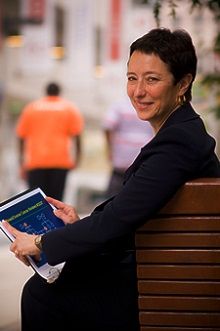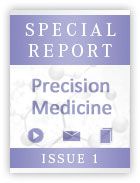Screening Needed for Younger Breast Cancer Patients Based on Mutation Yield
BRCA and other mutations occurred in more than 10% of estrogen-receptor–positive/HER2-negative invasive breast cancers in a cohort of women younger than 50 years of age, according to a report at the 2015 ASCO Annual Meeting.
Judy E. Garber, MD

Judy E. Garber, MD
BRCAand other mutations occurred in more than 10% of estrogen-receptor (ER)positive/HER2-negative invasive breast cancers in a cohort of women younger than 50 years of age, according to a report at the 2015 ASCO Annual Meeting.
Overall, 11 of 106 (10.4%) patients had a deleterious mutation. These included seven patients (6.6%) withBRCA1orBRCA2mutations. Other genes related to breast cancer identified through the analysis wereATM,CHEK2, andPALB2. One patient had a mutation in bothBRCA2andATM.
“Neither age at diagnosis nor family history distinguished carriers in this relatively small cohort of women diagnosed before age 50,” said Judy E. Garber, MD, director of the cancer risk and prevention clinic at Dana-Farber Cancer Institute in Boston. “National Comprehensive Cancer Network (NCCN) guidelines call for testing women with breast cancer diagnosed at age 45 years or younger, regardless of subtype. These data are a reminder to extend testing beyond patients with triple-negative breast cancer (TNBC),” Garber said.
Among women with newly diagnosed TNBC,BRCA1/2mutations occur in about 25% of tumors diagnosed at age 50 years or earlier and in 10% to 15% of tumors diagnosed at age 60 years or earlier. Epidemiologic data have shown thatBRCAmutation carriers who are younger than 50 years at diagnosis are more likely to have higher-grade ER-positive tumors.
Given the NCCN recommendation for testing women ages 45 years or younger, “We wondered whether we are missing patients who might benefit from targeted therapies if only those with triple-negative breast cancer are tested,” said Garber. “We looked beyondBRCAto begin to contribute to that epidemiology.”
Investigators obtained blood samples from consenting patients with invasive breast cancer. All patients were younger than 50 at diagnosis, had ER-positive/HER2-negative breast cancer, grade 3 (poorly differentiated) disease, and invasive cancer only. After exclusions for incorrect grade, insufficient DNA, and other factors, 106 patients remained for testing and data analysis.
The patient specimens were assessed by means of a next-generation sequence-based panel that identified mutations in 25 cancer predisposition genes. Investigators classified germline sequence variations and large rearrangements for pathogenicity.
The test panel identified deleterious mutations in 11 patients.BRCA1mutations were detected in four patients andBRCA2in three patients. Other cancer-predisposition genes identified in the study wereATMin two patients (including oneBRCAcarrier),CHEK2in one patient, andPALB2in two patients.
Investigators found one or more variants of unknown significance (VUS) in any gene in 47 of 106 patients. The VUS occurred alone in 39 cases and with a mutation in eight cases.
Mutations were more common among women of Ashkenazi Jewish ethnicity (3 of 11 mutations, 27.3%,P=.02), progesterone-receptornegative tumors (27.3% vs 5.3% of women without mutations,P<.01), and women who previously had undergone genetic testing (81.8% vs 41.2% of women without mutations,P= .01).
“Panel testing identified mutations beyondBRCA1andBRCA2in women with high-grade ER-positive/HER2-negative tumors diagnosed before age 50. Further research to assess the mutation rate in women diagnosed after age 50 years with grade III, ER-positive/HER2-negative cancers is warranted,” Garber concluded.
Garber JE, Tung NM, Elkin EP et al. Predisposing germline mutations in high grade ER+HER2- breast cancer (BC) patients diagnosed (Dx).J Clin Oncol.33, 2015 (suppl; abstr 1503).
<<<

Breast Cancer Leans into the Decade of Antibody-Drug Conjugates, Experts Discuss
September 25th 2020In season 1, episode 3 of Targeted Talks, the importance of precision medicine in breast cancer, and how that vitally differs in community oncology compared with academic settings, is the topic of discussion.
Listen
Powell Reviews Updated IO/TKI Data and AE Management in Endometrial Cancer
April 18th 2024During a Case-Based Roundtable® event, Matthew A. Powell, MD, discussed the case of a patient with advanced endometrial cancer treated with lenvatinib plus pembrolizumab who experienced grade 2 treatment-related hypertension.
Read More